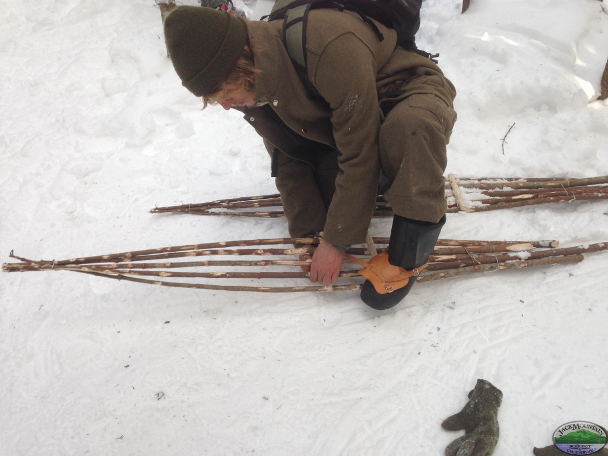This guest post is by Jerell Friesen, pictured in the photo above adjusting an improvised snowshoe during the 38 days described in the post. You can download a pdf with graphics by clicking here.
What I Did:
During the 38 day period between February 2nd and March 8th 2013 I dedicated myself to a two part snowshoe expedition where among other challenges I consumed pemmican as a sole source of sustenance. The time period was spent entirely outside, the work was honest and hard and the cold tested one’s mettle as the temperatures were consistently sub-zero.
Why I Did It:
It was a personal challenge and an a n=1 experiment. The percolating thoughts of embarking on this adventure came to fruition after a rambling discussion at the Jack Mountain Bushcraft School a few months prior to the snowshoeing expedition.
I initially became interested in pemmican after stumbling on information about a fascinating metabolic state called – ketosis. As mentioned in a post prior to the trip ketosis is a metabolic state of functioning where every cell in the body, of which there are approximately 37.2 trillion, makes a fundamental switch in it’s energy production mechanism.
This is nothing to scoff at. Yet, it is at this point in my descriptions of the ketotic body state that I most notice meiosis in my audience. I’ve found a generalized minimization of this most fascinating point, so I’ll restate it: ketosis is a metabolic state of functioning where every cell in the body, of which there are approximately 37.2 trillion, makes a fundamental switch in it’s energy production mechanism. I really can only venture a guess as to why this trivialization occurs, but there is a resistance I find to view the world in an extraordinary way. The world is profound but modern convenience has created and spread though the first world this virus that is – perceived insignificance but this doesn’t mean that the world is actually void of profound signification; there just always seems to be “bigger fish to fry” then to actually be present to see the worlds luminosity.
We may understand much about how life works but nobody really understands whats driving those 37 trillion cells to work in concert and to adapt to changing conditions. It’s a miracle and I was and still am fascinated with the bodies ability to conduct these adaptations. So I pushed my body to the limit because I suppose I’m striving to deepen a respect and understanding that small isn’t meaningless. I mean, jeez, we are an incarnate glowing iridescence of the incorporeal essence of life.
A Little About The Proposed Physiology:
While I was expressing my intention to subsist entirely on pemmican for the duration of the sub-zero snowshoe expedition I was asked on multiple occasions how the ketotic state differs from a diet simply high in fat – say 50% fat, 25% protein, 25% carbs. The individuals were curious as to why it is important to eliminate carbs if they are still getting the calories from the fat in the diet.
Danny Albers on his blog ‘Primal North’ wrote a very clarifying article called called Keto-adaptation vs low carb limbo. In the the article he states:
Being “fat adapted” is almost a misnomer. Even on a high carb but lower calorie diet we can access body fat to fuel this baseline energy system.
I would submit that every single person is already “fat adapted” to some degree. If you starve a person, no matter how obese, they will almost immediately start to draw caloric energy from body fat via fatty acid oxidation. There is no training needed for the body to start burning body fat for fuel via fatty acid oxidation. We can all do it already.
Fatty acid oxidation as energy system can be trained so that like other energy systems, it can ramp up and provide greater amounts of energy. If you follow Mark Sisson’s Primal Blueprint you will note that most of the time spent “moving slowly” draws on the fatty acid oxidation system. All those long walks in the sunshine are essentially training this system to ramp up if needed.
It’s clear that the body accesses and utilizes fatty acids efficiently at rest and at lower levels of physical activity.
As per Jeff Volek, PhD, RD & Stephen Phinney, MD, PhD in their book ‘The Art and Science of Low Carbohydrate Living’ – the peak rate of fat burning occurs on average at about 50-65% of maximal oxygen consumption. This is exactly the level of activity that would be expected on a snowshoe expedition.
So again why ketosis? When the process of keto-adaptation is completed, muscle both at rest and during exercise, comes to rely heavily on fatty acids and to a lesser degree ketones. Ketones are created in the liver and this important adaptation spares the hepatic ketone production for use by other tissues, especially the brain; as the brain can only burn glucose or ketones.
The buildup of blood ketones caused in part by a decreased utilization in skeletal muscle allows a higher concentration to be transported into the brain for use as a fuel source. The book ‘The Art And Science Of Low Carbohydrate Performance’ describes that when oxidation of ketones in skeletal muscle is reduced blood ketones rise, this adaptation facilitates an increase in ketone transport across the blood brain barrier to meet the majority of the brains demands.
Conversely while non-ketotic the brain’s primary fuel is only glucose despite the fact that fatty oxidation may be occurring and ketones may be produced and utilized by the muscles. In this way if glucose stores are consumed the brain may run out of fuel, even if the muscles of the body are still able to utilize fatty acids. This phenomenon is called hitting the wall, or bonking and it is common in marathon runners and endurance athletes.
If an individual undergoes the ketotic metabolic shift the whole body system will be harmonized to run off fatty acids; including the brain. This improves cognition during times of prolonged exercise like during a snowshoe trek. This seems highly advantageous as poor judgements during a journey of that nature can compound into life threatening situations.
The ketotic state also:
- Eliminates the problem of blood sugar crashes and chills that may occur after a skipped meal. This protects against hypothermia.
- Maintains a better nitrogen balance and therefore is protective against muscle tissue loss (muscle tissue is not broken down to supply sugars to the brain and heart).
- Decreases oxidative load on body system (fatty acids produce less reactive oxidative species) This increases recovery and decreases muscle soreness.
For more information on the topic take a look at the books: ‘The Art and Science of Low Carbohydrate Living’, and the ‘The Art and Science of Low Carbohydrate Performace‘ both by – Jeff Volek, PhD, RD & Stephen Phinney, MD, PhD. Much of the information on this post is derived from that resource.
My Real World Experiences And Recommendations
I experienced much during the trip. My initial reaction to eating simply pemmican was positive. For 6 weeks prior to the trip I had removed carbohydrates from my diet and had tested my blood ketone levels during approximately a month of that period. Here are the results of those tests.
My ketones stayed within the optimal ketone range on 1.0-3.0 most of the period between Dec. 26- Jan 28th. Although there are a few days were it dips below the 1.0 threshold. I attribute this to an overconsumption of meat of a few occasions (excess protein can actually kick one out of ketosis). Also I occasionally hit ketone levels of >4.0. This is a sign of something called starvation ketosis. This is an indication that more calories need to be consumed to prevent a significant loss in body mass.
Positives:
Lack of hunger:
During the trip and in my ketotic state previous to it I found a significant change in my appetite. It was as though my desire to eat moved from being a physical need to a chance to enjoy a tasty meal. Meal time became more of a art form I suppose because I never felt that I ‘had’ to eat. When I did get hungry it was a passing sensation usually more mental than physical; a product of a need to ameliorate boredom or to satisfy a need for satisfaction in some manner.
Cold, but never chilled:
I’ve noticed, in other times while not in ketosis, that a missed meal can result in a headache, a short temper, and most importantly a low tolerance for cold. I’m sure most people have experienced these things at one point or another. These symptoms were completely absent while ketotic as ketone levels are actually increased during exercise and during fasting. My ability to tolerate cold was more dependent on my moment to moment level of stress.
The other expedition members never missed a meal or a chance to re-carb. So I can’t say based on my observations where a missed meal would put them, but I can say based on my previous experience with slight hypoglycaemia that it could lead to a potentially dangerous situation.
Low pack weight:
Pemmican is extremely calorie dense, at a liberal 4000 calories per pound. This allows an unbelievably low pack weight and for the entire 38 days on trail I brought only 50 pounds. I only consumed 36 although this is still about 150,000 calories. I will point out that on less strenuous trips one could subsist on about half of what was being consumed here; a 7 pound pack of pemmican could last 2 weeks!
Considerations:
Emotional aspect of low satisfaction:
As mentioned above meal-time became a chance for an emotional uplift. It became an alchemical tool to cast one’s spirits into better forms. Yet as the days of consuming pemmican continued the alchemical power of that food faded, and faded quickly. I will admit there were limitations in the amount of satisfaction that I could squeeze out of the pemmican and I often left feeling replete but not content. I did for a while during the beginning of the treks have a few spices to season the pemmican and this, for a time, helped return the meal into a transformative experience. I found though, that after trying all the spices I had, all flavours had a sharp drop off in palatability except for the flavour and texture of meat; this always kept its luster. I don’t understand why the bland flavour of the simple pemmican maintained it’s palatability but it remained so, and after much experimentation I settled on simply cutting off pieces of my daily one pound blocks and consuming them in that state. It became a routine and I simply found other ways of acquiring emotional nourishment. Engaging activities like chopping wood or journal writing, became more special, as it was in these pursuits that the moment grew larger, the space between choices lengthened, and the flow of happenstance was released to the control of sense more rooted in the rhythms of nature than in mind. Yet there was always a constant and unabating reminder that a good meal is much more than just food.
Monitor your ketone level with a blood ketone meter:
During the trip I sporadically tested my ketone levels. Why you ask? Were you not already deep into ketosis? Well, while in the ketotic state one’s body can occasionally move into something called starvation ketosis as stated above. So I wanted to occasionally monitor my levels to ensure that I was in fact eating enough. And I usually was with the exception of a few days, where we snowshoed an abnormal and inhuman amount.
Overeating:
After a few days of hard work I began to feel the need to eat more. Yet there is certainly a limit to the digestible amount of pemmican one can consume at once. On a few occasions I felt the need to consume more than normal. When I indulged myself in more that 1/3 of a pound I would quickly get sick and would have to sit still for a while to allow my stomach to settle. I realized that to be able to process this food I would need to eat smaller amounts of it throughout the day.
Dehydration:
While ketotic I found it very easy to become dehydrated. This is a great concern on a winter snowshoe trip as it is sometimes difficult to consume enough water; especially if the water is ice cold. I found personally that dehydration decreases circulation. Compared to the other members of the group my extremities would quickly become cold and numb and constant care was needed to prevent frostbite. I was actually unable to leave the adventure without a trophy of a single days dehydration; my left ring finger, frostbitten after ignorance, was and still is a constant reminder to consume enough water. I believe this may have something to do with the fact that while in ketosis one’s body literally holds less water. The molecules of glycogen, which are stored sugars in one’s body, bind to water molecules. This increases one’s fluid carrying capacity. In my experience it felt as though water flowed right through me and constant hydration was key. If I didn’t hydrate properly I would feel sluggish and tired; on top of the said risks above that’s just not a recipe for a good time.
General low energy or resistance to high exertion activities:
While ketotic your body still produces glycogen that is stored in the muscles and in the liver, however it is a slow process and one can exhaust the bodies ability to synthesize sugars if you ‘run the tank’ dry so to speak. The result is a resistance to higher level activity as there is literally no energy available for activities that require a heart rate greater than 50-65% of ones maximal oxygen consumption. As it is at and above this threshold that the enzymatic rate limit is reached and the cells must turn to carbohydrate oxidation to generate ATP or cellular energy. This is why the ketotic diet is not appropriate for sprinters or MMA fighters as these sports require short bursts of high energy.
Even during the period previous the trip when I had been ketotic I noticed a generalized lassitude. There just simply seemed to be a resistance to “trying hard”. I could go at my own pace for days but there was mountainous somatic objection to kicking things into the high gears. It seemed as though my body ‘knew’ that high levels of physical activity required sugars, which at this point were only produced in by body in minuscule amounts and stored just in case of a ‘fight or flight’ situation. My past has been full of sports and sport specific training so I know how to push myself; but some days wore on me as we pushed hard and I dipped into my glycogen reserves. Every time I felt myself digging deep I wore into that tank and my ability to ‘try’ slowly diminished to a point where I was literally unable to give more than my pace; a level admittedly slower than some other members of the group but, I could go at that pace comfortably and easily all day – literally. The breaks I took to eat were simply taken to spread out the pemmican over greater time so it would be easier to digest.
This difference did create some tensions between myself and the other members of the group as my movements, and my temperament we very protracted. I basically took a long time to do things, and I think this may have appeared as laziness. I would in fact make a recommendation, for anyone interested in attempting this experiment, that ketosis should an be all or none group activity as the ketotic individual may become un-relatable to the others members of the group. Most have never had the experience of being in a ketotic state and will have a difficult time understanding and appreciating the situation.
I found however, and this may be the most profound revelation of the trip, that laughter, elicited by any and all ridiculous means, proved reliably to be the most powerful and transformative activity. It consistently recast my demeanour and reenergized my spirits in the hardest moments of the trip. Despite pitfall and bad fortune a gut busting, ab tearing, breath stealing monster of a laugh supercharged my circuits and propelled me to a state where it seemed ketone production had hit a maximum, although unfortunately for now at least I have no proof of that fact. All in all this really reinforced that unabating sense that food is mostly alchemical and that life’s joys are really the greatest treasures.
In Closing
This experience was an adventure. I had always been in interested in the ketotic state and the ability of the body to adapt; so it was amazing to feel the same effects proposed by the physiologists. It also gives tremendous credence to the claims proposed by the advocates of ketosis. I mean this is actually a way of eating that gives sensations congruent with the more abstract expectations. This to me is pretty exceptional. It’s biology with a hands on attitude and out of this one can really begin to respect what these physiologists are saying.
Finally I would like to state that during a winter camping or snowshoeing adventure this food is highly functional, with the following caveats:
- Drink plenty of water and consume adequate electrolytes.
- Expect a lower but more steady energy level (Unless of course you can schedule a spontaneous laugh attack every 3 hours!).
- Organize the trip such that all or none of the participants are ketotic.
- Prepare for an increased amount of time with which to gain emotional nourishment, not available from the joys of normal meal preparation and consumption.








